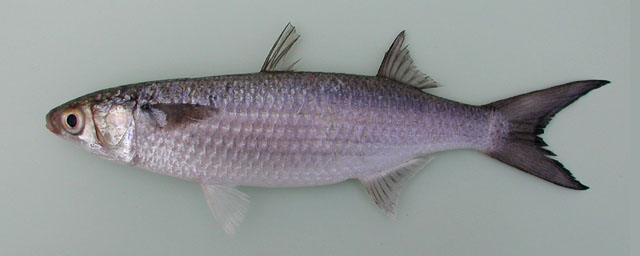|
Anal spines: 3; Anal soft rays: 8-9. Diagnosis: body moderately stout, rounded in cross-section; head large, interorbital space almost flat; adipose eyelid well developed, extending unto pupil; upper lip thin, not ornamented (Ref. 57400). Upper lip with single comb-like series of setiform/cilliform, recurved (Ref. 57400, 81659), longish (Ref. 57400) unicuspid teeth, just visible to the naked eye as a fine fringe, and no inner rows (Ref. 81659). Lower lip without teeth, or with a single comb-like series of minute ciliiform teeth (not visible to naked eye) (Ref. 81659). 2nd row at base of lower lip in small fish (Ref. 57400). Hind end of upper jaw reaching a vertical line from posterior nostril; maxillary pad not visible below corner of mouth when closed; origin of first dorsal fin nearer to snout tip than to caudal-fin base; pectoral axillary process well developed (31.5-33% of pectoral-fin length)(Ref. 57400). 11-12 scale rows between origins of 1st dorsal and pelvic fins; anterior parts and bases of second dorsal and anal fins (sparsely) scaled; pelvic fins, anal and lower caudal fin lobe greyish to more or less whitish (never yellowish) (Ref. 57400, 81659).
Description: 5-6 rows of small papillae often arranged in band around ventral margin of lower lip; 33-39 (usually 36-37) scales in longitudinal series (excluding scales on caudal fin base); 11-13 (usually 12) scale rows between pelvic and first dorsal fins; 17-20 (usually 17-18) circumpeduncular scales, just anterior to point of caudal flexure; 2nd dorsal and anal fins with small scales anterobasally, otherwise naked; anal fin with 3 spines and 8 (rarely 9) segmented rays in adults (1st spine very short and usually hidden by overlying scales), usually 2 spines and 9 soft rays in juveniles <35 mm SL; pectoral fin 69-78% of head length, with 1 short, unsegmented ray dorsally and 14-16 (mode 15) longer, segmented rays; pharyngobranchial organ with single, large valve, often longer (anteroposteriorly) than deep (dorsoventrally)(Ref. 81659).
Coloration: greyish-brown dorsally; flanks silvery (more than M. cephalus) with dark longitudinal bands present or absent (usually less numerous than in M. cephalus)(Ref. 57400, 81659). Dorsal fins dusky; pectoral, pelvic, and anal fins paler or whitish; caudal fin also pale, particularly on lower lobe; pelvic, anal and caudal fins not yellowish (cf. Mugil cephalus); dark spot at origin of pectoral fin; in preserved specimens, dorsum dark brown, flanks lighter brown or silver, and ventral parts of body pale or silvery (Ref. 81659). |
| Inhabits coastal waters (Ref. 2683, 7399, 57400), estuaries (Ref. 2683, 7399, 81659), inshore marine waters and lagoons (Ref. 81659). Also in high salinity waters (up to 73‰)(Ref. 57400). Feeds on phytoplankton and detritus (Ref. 28587). Oviparous, eggs are pelagic and non-adhesive (Ref. 205). Maximum FL reporded 260mm (Ref. 57400), maximum SL 260 mm, common length 200 mm SL (Ref. 81659). |

